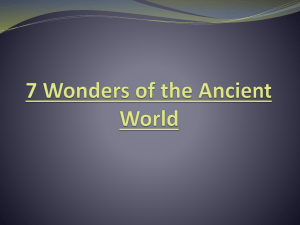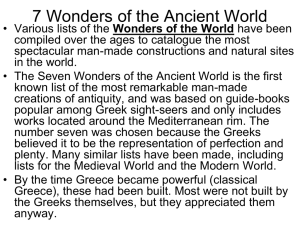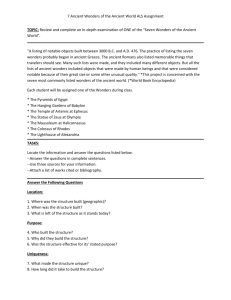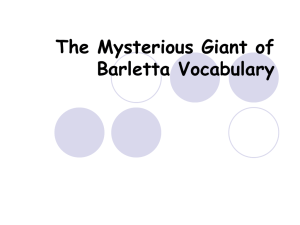Gr_3_Reading_Comp_Practice_Set_6
advertisement
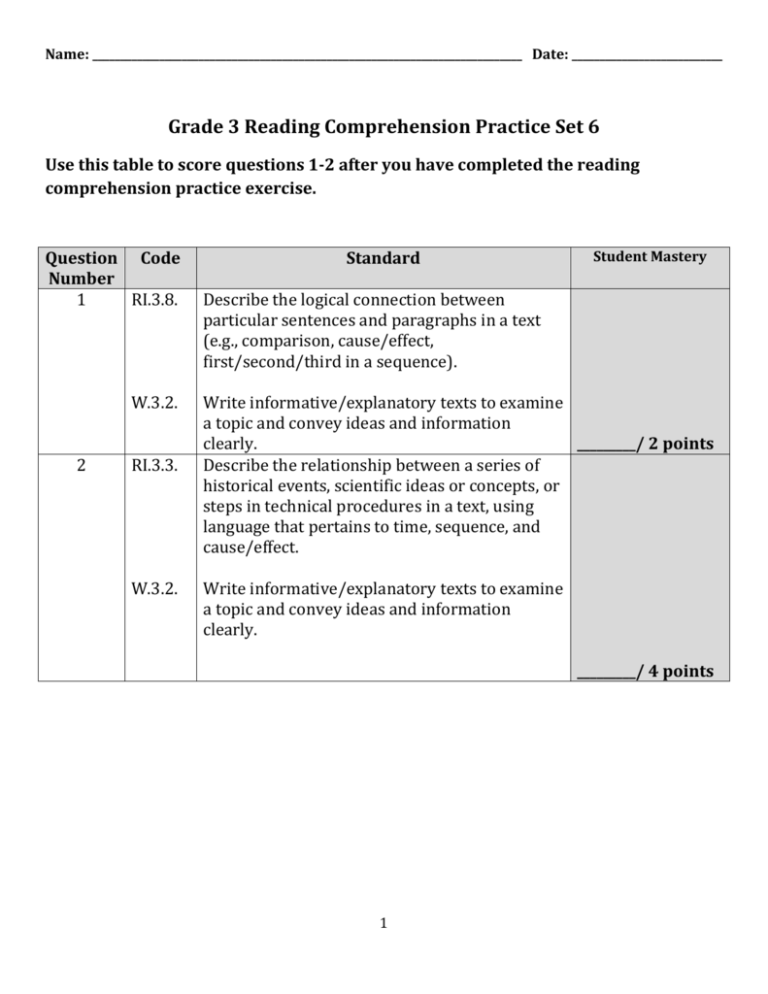
Name: _____________________________________________________________________________ Date: ___________________________ Grade 3 Reading Comprehension Practice Set 6 Use this table to score questions 1-2 after you have completed the reading comprehension practice exercise. Question Code Number 1 RI.3.8. W.3.2. 2 RI.3.3. W.3.2. Standard Student Mastery Describe the logical connection between particular sentences and paragraphs in a text (e.g., comparison, cause/effect, first/second/third in a sequence). Write informative/explanatory texts to examine a topic and convey ideas and information clearly. _________/ 2 points Describe the relationship between a series of historical events, scientific ideas or concepts, or steps in technical procedures in a text, using language that pertains to time, sequence, and cause/effect. Write informative/explanatory texts to examine a topic and convey ideas and information clearly. _________/ 4 points 1 Pre History: The Seven Wonders of the Ancient World Used with permission by ReadWorks.org Read the passage. Then answer question 1 in the space provided. Have you heard of the seven wonders of the ancient world? These are seven impressive 1 objects built between the years 3000 B.C.E. and 500 C.E. Most of these objects do not exist today, but they did in the ancient world. Starting with the oldest, here are the seven wonders of the ancient world and some facts about each one. 1. The Great Pyramid of Giza Where is it? Giza, Egypt When was it built? Around 2600 B.C.E. Facts: The Great Pyramid stands at 450 feet high. The base covers 13 acres. This is the only one of the ancient wonders that is still standing. You could visit it today! 2. The Hanging Gardens of Babylon Where were they? Babylon, the city that is now Baghdad in Iraq. When were they built? About 600 B.C.E. Facts: The Hanging Gardens are the only ancient wonder that may not have been real. The hanging gardens were built by King Nebuchadnezzar II of Babylon. They were built to honor one of his many wives. The gardens hung above the city. Some were 75 feet high. Unfortunately, the gardens no longer exist. 3. The Temple of Artemis at Ephesus Where was it? Ephesus, now a part of Turkey When was it built? 550 B.C.E. Facts: This temple, dedicated2 to the Greek goddess Artemis, was one of the biggest temples of the ancient world. It was made out of marble. It had 106 columns. It was 40 feet wide and 377 feet long. The temple was destroyed in 262 C.E. 1 2 impressive—having the power to affect someone strongly dedicated—set apart for a special purpose 2 4. The Statue of Zeus Where was it? Olympia, Greece When was it built? About 457 B.C.E. Facts: Zeus was the Greek ruler of the gods. This statue of him was one of the most famous statues in the ancient world. It was 40 feet high and made of ivory and gold. A fire destroyed the statue in 426 B.C.E. 5. The Tomb of Halicarnassus Where was it? Turkey When was it built? About 353 B.C. Facts: The tomb held the remains of Mausolus, a ruler of the Persian Empire. It stood 140 feet high. Its base had 36 columns. Today, some parts of the tomb are in the British Museum. 6. The Pharos Lighthouse of Alexandria Where was it? Alexandria, Egypt When was it built? About 280 B.C.E. Facts: This lighthouse stood over 400 feet tall in Alexandria’s harbor3. A fire burned at top of it and its light guided ships. An earthquake destroyed the lighthouse over 500 years ago. Then, in 1994, divers found what they believe are the remains of the lighthouse in Alexandria’s harbor. 7. The Colossus of Rhodes Where was it? Rhodes, an island in Greece. When was it built? Around the early 200s B.C.E. Facts: The colossus was a statue of the Greek sun god Helios. It straddled4 the entrance to the harbor at Rhodes. The statue was made of bronze and took 12 years to build. It stood 120 feet tall, about as big as the Statue of Liberty. An earthquake destroyed the colossus in 224 B.C.E. 3 4 harbor- a body of water that holds boats straddled—stood with legs on either side of 3 Answer questions 1-2 in the spaces provided below. 1. In paragraph 1 the author states, “Most of these objects do not exist today, but they did in the ancient world.” Explain why this statement is true. Support your answer using at least two details from the text. ______________________________________________________________________________________________ ______________________________________________________________________________________________ ______________________________________________________________________________________________ ______________________________________________________________________________________________ ______________________________________________________________________________________________ ______________________________________________________________________________________________ ______________________________________________________________________________________________ ______________________________________________________________________________________________ ______________________________________________________________________________________________ ______________________________________________________________________________________________ ______________________________________________________________________________________________ ______________________________________________________________________________________________ ______________________________________________________________________________________________ ______________________________________________________________________________________________ ______________________________________________________________________________________________ ______________________________________________________________________________________________ Score 2 1 0 Response Features • Valid inferences and/or claims from the text where required by the prompt • Evidence of analysis of the text where required by the prompt • Relevant facts, definitions, concrete details, and/or other information from the text to develop response according to the requirements of the prompt • Sufficient number of facts, definitions, concrete details, and/or other information from the text as required by the prompt • Complete sentences where errors do not impact readability • A mostly literal recounting of events or details from the text as required by the prompt • Some relevant facts, definitions, concrete details, and/or other information from the text to develop response according to the requirements of the prompt • Incomplete sentences or bullets • A response that does not address any of the requirements of the prompt or is totally inaccurate • A response that is not written in English • A response that is unintelligible or indecipherable 4 2. Compare and contrast the Temple of Artemis at Ephesus to the Statue of Zeus. Use at least two details about each ancient wonder to support your response. In your response, be sure to: Explain how the Temple of Artemis at Ephesus and the Statue of Zeus are similar Describe differences between the Temple of Artemis at Ephesus and the Statue of Zeus Use at least two details about each ancient wonder to support your response __________________________________________________________________________________________ __________________________________________________________________________________________ __________________________________________________________________________________________ __________________________________________________________________________________________ __________________________________________________________________________________________ __________________________________________________________________________________________ __________________________________________________________________________________________ __________________________________________________________________________________________ __________________________________________________________________________________________ __________________________________________________________________________________________ __________________________________________________________________________________________ __________________________________________________________________________________________ __________________________________________________________________________________________ __________________________________________________________________________________________ __________________________________________________________________________________________ 5 ANSWER KEY 1. In paragraph 1 the author states, “Most of these objects do not exist today, but they did in the ancient world.” Explain why this statement is true. Support your answer using at least two details from the text. Answers will vary. Use the enclosed rubric as a guideline for scoring. Example of a 2-level answer: It is true that “Most of these objects do not exist today, but they did in the ancient world” because most of the different ancient wonders were destroyed. For example, a fire destroyed the statue of Zeus in 426 B.C.E. The remains of the pharos lighthouse were discovered in 1994. These details show that these objects no longer exist. Suggestions for class review: This question requires students to identify textual evidence that adequately supports the idea that most of the objects do not exist today. Students will need to pay close attention to details about how most of the different ancient wonders were destroyed and use inferencing skills to understand that if something was destroyed, it does not exist today. Ask students to annotate the text for information that supports the idea that the different objects no longer exist. There are several details beyond the ones listed that support this idea. Ask students why this information would support the idea that most of these objects do not exist today and help them make the connection. Score 2 1 0 Response Features • Valid inferences and/or claims from the text where required by the prompt • Evidence of analysis of the text where required by the prompt • Relevant facts, definitions, concrete details, and/or other information from the text to develop response according to the requirements of the prompt • Sufficient number of facts, definitions, concrete details, and/or other information from the text as required by the prompt • Complete sentences where errors do not impact readability • A mostly literal recounting of events or details from the text as required by the prompt • Some relevant facts, definitions, concrete details, and/or other information from the text to develop response according to the requirements of the prompt • Incomplete sentences or bullets • A response that does not address any of the requirements of the prompt or is totally inaccurate • A response that is not written in English • A response that is unintelligible or indecipherable 6 2. Compare and contrast the Temple of Artemis at Ephesus to the Statue of Zeus. Use at least two details about each ancient wonder to support your response. In your response, be sure to: Explain how the Temple of Artemis at Ephesus and the Statue of Zeus are similar Describe differences between the Temple of Artemis at Ephesus and the Statue of Zeus Use at least two details about each ancient wonder to support your response Answers will vary. Use the enclosed rubric as a guideline for scoring. Example of a 4-level answer: The Temple of Artemis at Ephesus and the Statue of Zeus are both similar and different. They are similar because they are both considered part of the seven wonders of the ancient world. They were both also objects that were dedicated to different gods. The temple was dedicated to the Greek goddess Artemis and the statue was dedicated to the Greek ruler of the gods. They are different because they were made of different materials. The temple was made of marble and the statue was made of ivory and gold. The temple of Artemis was destroyed after the statue of Zeus. The statue was destroyed in 426 B.C.E., while the temple was destroyed in 262 C.E. While these two ancient wonders are similar in some ways, they are also different. Suggestions for class review: This question requires students to compare and contrast the Temple of Artemis at Ephesus and the Statue of Zeus. There is plenty of information available about both ancient wonders, but students might struggle to identify differences and similarities. Remind students of the importance of using graphic organizers such as a venn diagram to help them pre-write before answering a question like this. Brainstorm some similarities and differences as a class. Encourage the students to go back to the text and carefully examine the details about both ancient wonders. Remind students to think about basics- who, what, when, where, why, and how—when thinking about similarities and differences. 7 8

